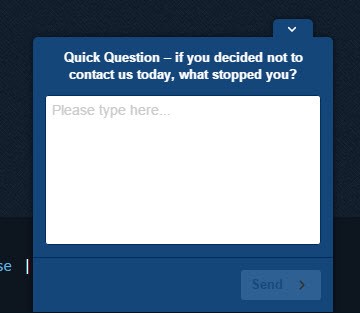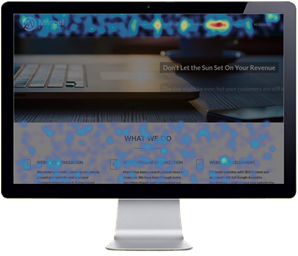
When hypothesizing and researching for a Conversion Rate Optimization campaign, it’s important that you get more insights as to where the actual pain points are for your customers. Always remember that while there may be ideas or assumptions you would like to test, those may not be the most pressing issues on your website, and even then, they might not even be issues for your users! You have a wealth of capabilities in various tools that allow you to get a more enlightened look at your audience and their interaction with your website, so it’s important that you leverage these data sources and points to their fullest capabilities.
Below we put together a list of ways that you and your team can gather information about your user’s interaction with your website. Using these tools and tactics below will help you better understand your user’s thought process and how they are using your website. You will get in depth analysis that will help you better communicate your ideas and thoughts on how your website can be better, and also get a better chance of buy in from your decision makers.
Leverage Your Analytics
Hands down, the most effective tool that you will have your CRO arsenal is your analytics platform. As a Google Certified Partner, we at Marcel Digital prefer (and HIGHLY suggest) Google Analytics and Google Tag Manager, but there are other platforms out there that can give you data insights.

The reason tools like this are so effective is because there are your single source of truth. No other tool will tell you more about your audience, where they came from, where they went on your website, how they interacted with your website, and ultimately if they converted or not. You’ll also be able to see key performance indicators (KPIs) providing in-depth metrics to show you more about how your website can be improved. For instance:
- Bounce rates
- Time on site
- Traffic sources
- Site speed
- Exit rates
- Conversions
Using these metrics can give you a clear path to what tests need to be ran to improve the overall conversion rate of your website. Data can be pretty intimidating, but when you are leveraging your data in a way that helps your thought process to ultimately improve your website’s functionality, it becomes more and more transparent and easy to use! Practice makes perfect!
Ask Your Audience Questions
Why not go direct to the source? Marcel Digital highly recommends asking your users questions and getting them involved in the experience of your website. There are a ton of tools across the web that allow you to ask your audience members questions and take polls; both a highly effective way to find out what your users think of your website and how it can be better.

Whenever you ask your audience questions, make sure that the questions ask are not simple “yes” or “no” answers. Phrase questions in a way that ha the audience giving you information or insights into their thought process, you’ll be surprised how many users will tell you how and why they are using your website. This is also an enlightening strategy because you’ll hear issues that you may didn’t even know existed and you’ll hear advice on how to make your website better for those who matter most - the one’s answering the questions, your audience!
Advice on how to ask questions:
- Keep questions short
- Don’t lead surveys
- Ask for specifics
- Ask open-ended questions
- Consider a gift if possible!
Most importantly, listen to the audience members. One more time - listen. This information that users give you is vital to the success of your website. If they do not see a brand listening to them or engaging them on their responses, users will notice and go to a company or brand that will. Do not take them for granted, make sure their voices are heard!
Unlock The Power Of Visuals
One of the most effective ways, if not THE most effective way, to show data is through visuals. A visual can be any optical representation of a user’s engagement on a website. The reason that these are so effective when it comes to CRO, is because they show you exactly what movements a user is making on your website, where they are clicking, how far they scrolled down your page, and ultimately what elements on your page are the most engaging.
So, what are some examples of visuals that we regularly utilize?
- User videos
- Heatmaps
- Click maps
- Scroll maps
- Eye maps
- And more!

All of the visuals listed above will help your team understand what factors are influencing your customer’s behavior and also help you go through the thought process of improving your website’s user experience. Visuals help you:
- Identify patterns in user engagement
- Comprehend issues and information more effectively
- Communicate thoughts and ideas to members of your team
- Learn more about your audience’s thought process
We cannot stress enough of valuable visuals are in the persuasion of CRO. When a brand leverages visuals in their CRO campaign to make informed decisions, the issues become clearer, the solutions become reinforced, and the results speak for themselves.
Follow-Up With Your Customers
One of the biggest mistakes we see companies make when it comes to customer retention is following up after the conversion. This is a mistake for two reasons:
- You miss the opportunity for feedback
- You miss the opportunity to retain that customer
Customers want to feel like the most important person in the world when speaking with a company. They want to feel that their experience with your brand is nothing short of spectacular, and following up with a quick “How did we do? What can we do better?” speaks volumes about the type of brand you are and the type of brand you want to become.
When you ask a customer for feedback, you’re essentially telling them “We want to better and we want you to be a part of that goal; we want your thoughts, they are important”. Take advantage of tools and services that allow you to follow up with customers and ask great questions - you’ll get important information, they’ll feel important, and your brand equity will benefit substantially. Don’t be the brand that gives lip service; be the brand that shows it cares and listens.
At Marcel Digital, we want to be your trusted business advisor. If you have any questions or comments about Conversion Rate Optimization, our cross trained team is ready to help in whatever way we can! We’d love to learn more about you and your business, so please feel free to contact us and let us know how we can help you and your team today!
Conversion Rate Optimization
About the author
Kyle Brigham
Kyle Brigham is the Chief Strategy Officer at Marcel Digital. He specializes in client services and project management, but also original Nintendo games and ping pong.